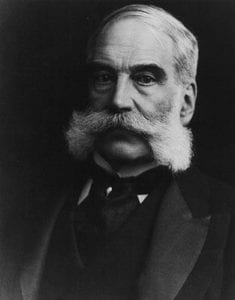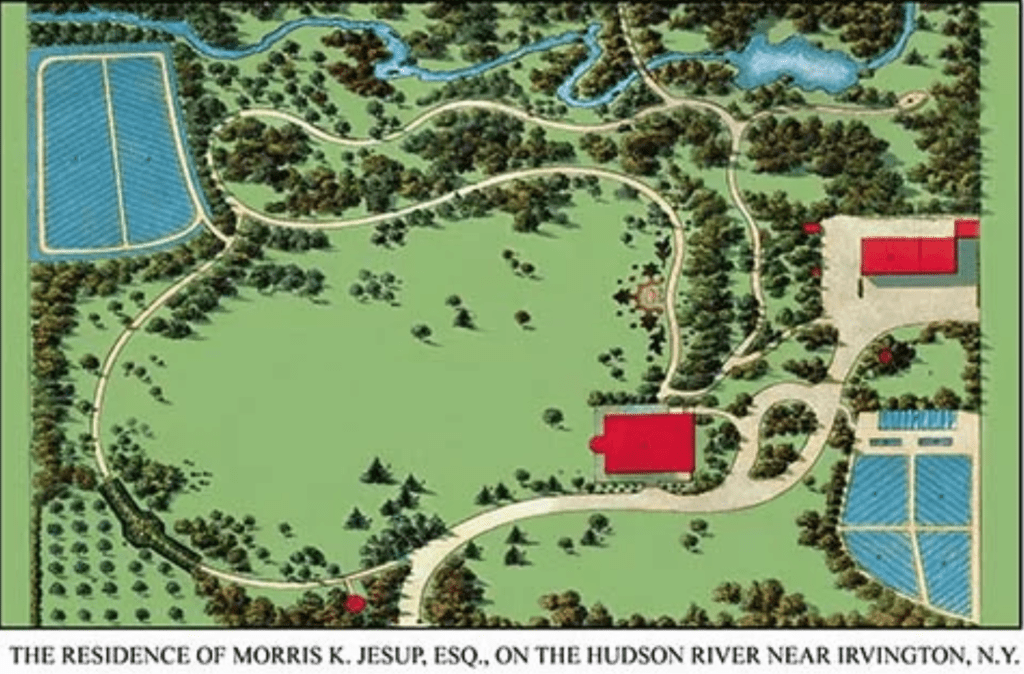El Retiro
by The Irvington Historical Society
In September 1877, Caroline Amelia Shields Rubira purchased a 5.4-acre estate in Irvington to use as a summer home. Ms. Rubira was raised in Mobile, Alabama, and, at the time she purchased her summer retreat, was married to Santos Santiago Rubira, a prominent member of the Mobile business community. The Rubiras named their new Irvington summer estate “El Retiro”.
This property, which was located just west of the Croton Aqueduct and south of what today is Station Road, was once part of the 285-acre farm owned by John Jewell, one of the early settlers of what would become the Village of Irvington. The house and grounds purchased by Ms. Rubira were originally designed and built by Morris K. Jesup, the owner of the estate from 1863 to 1874.

Jesup was a banker in New York City and active in a wide variety of philanthropic endeavors – he was a patron of scientific research and exploration, a Charter Member, Trustee and President of the American Museum of Natural History and, for many years, a supporter of the natural outdoors known for leading efforts to “sav[e] the woods and waters of the State [of New York].” Working with the Austrian gardener Ignatz A. Pilat, Jesup used his Irvington property to create a beautiful summer home and landscaped gardens, which offered expansive views of the Hudson River. Jesup’s Irvington estate reflected the new discipline of landscape architecture and was featured in Jacob Weidenman’s seminal 1870 work Beautifying Country Homes.

After deciding in 1873 to move to a new summer residence in Bar Harbor, Maine, Jesup sold his Irvington estate to Edward P. Beach, who then sold the property three years later to Caroline Rubira.
Ms. Rubira, whose family could trace their lineage back to the Revolutionary War, was originally married to Edward H. Caldwell, the president of the Mobile Gas Light and Coke Company and a man who “lived the life of a prosperous southern gentlemen of ante-bellum days.” Following Edward Caldwell’s death in 1872, she married Santos S. Rubira, who had been born in Spain and who was now living in Mobile. After she bought the Irvington estate in 1877, she and her husband may have chosen to name the estate “El Retiro” after Parque del Buen Retiro – the “Park of the Pleasant Retreat” – which was one of the largest public parks in Madrid, Spain.

Several years after she purchased her summer home in Irvington, Ms. Rubira’s daughter from her first marriage, Sarah Caldwell, met and married Nathaniel E. Rutter. Nathaniel Rutter was a banker in New York City and the son of James H. Rutter, the President of the New York Central and Hudson Rail Road Company and a resident of Irvington. Sarah and Nathaniel Rutter’s son was born in Irvington in February 1890, but ten months later Nathaniel died of pneumonia, leaving Sarah a widow and mother of a young infant. Shortly thereafter, the Rubiras stopped coming to their summer estate in Irvington, and the house and the property was left unused for approximately twenty years.
In 1912, El Retiro was sold at auction to Irvington resident Edwin B. Katte, who at the time was Chief Engineer of Electric Traction for the New York Central Railroad and responsible for electrifying all of the train lines in and out of New York City. Katte immediately subdivided the property and sold the eastern half to Katherine S. Plummer, the wife of John S. Plummer, another Irvington resident. John Plummer was a Manager of the Locomobile Company, an early auto manufacturer that had been established by two other Irvington residents, John Brisben Walker, the owner of Cosmopolitan Magazine, and Amzi L. Barber, a pioneer in the asphalt industry in the United States.
The original house on the property, which had been used as a summer retreat by the Jesup and Rubira families for many years, was located on the half of the property purchased by the Plummers. They chose to tear down the existing house and build a new mansion, which they named “Glen Brea.” That house – today re-named “Villa Verde” – still sits on the property, and can be seen when walking on the Old Croton Aqueduct.
Links for Further Reading:
For a map and a detailed description of the grounds of El Retiro as originally designed and built by Morris K. Jesup, see Jacob Weidenmann, Beautifying Country Homes: A Handbook of Landscape Gardens – Illustrated by Plans of Places Already Improved (Orange Judd and Co. 1870), at 142-44, available at https://babel.hathitrust.org/cgi/pt/search?q1=jesup&id=wu.89034654285&view=1up&seq=14.
For a brief biography of Ignatz A. Pilat, who designed the grounds of Morris K. Jesup’s summer estate in Irvington, see Ignatz Anton Pilat, The Cultural Landscape Foundation, available at https://tclf.org/pioneer/ignatz-pilat
For a description of Morris K. Jesup’s life and work, see William Adams Brown, Morris Ketcham Jesup – A Character Sketch (Charles Scribner’s Sons 1910), at 205, available at https://archive.org/details/morrisketchumjes00brow/page/n9
